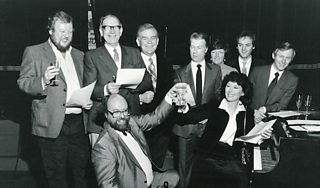40 years of 'Good Morning Scotland'
Graham Stewart
Broadcaster and Journalist, ������̳ Scotland
Tagged with:
Graham Stewart is a broadcaster and journalist with ������̳ Scotland and has been extensively researching the history of Scottish broadcasting for a forthcoming book. Here, he looks at the history of the nation’s biggest and longest-running radio programme as it celebrates its 40th anniversary this Hogmanay.��
At 6.45am on Hogmanay 1973, Good Morning, Scotland crept surreptitiously onto the airwaves for the first time. Upon first listening it seemed as if little had changed: Scottish news, weather and travel had been heard at breakfast time since the early 1960s, when ������̳ Scotland first began 'opting-out' from the Radio 4 network. Even the presenters, John Milne and David Findlay, were familiar voices, having regularly fronted the programme’s predecessor, Today In Scotland. But whereas that former programme had been a mere 20-minute 'opt-out', it quickly became apparent that Good Morning, Scotland, was a complete replacement.
It was a bold, ambitious and deeply controversial decision. Many listeners felt the previous set-up offered them the best of both worlds; but now, suddenly deprived of Today, they had to make do with a ������̳ Scotland alternative that struggled to match its ambition. To add insult to injury, the gaps between the items were filled with a mix of light and instrumental music - everything from Mrs Mills on the organ to James Last’s Elizabethan Serenade and Swinging Safari as performed by Jim MacLeod and his band. At the time, John Milne thought the music would never last. He was right; within two weeks the records had gone.

Good Morning Scotland's presenters celebrate the programme’s 10th anniversary in 1983. Back row: Mike Russell, Bill Jack, Magnus Magnusson, John Milne, Joanna Hickson, Haig Gordon, George Reid. Front: Neville Garden, Mary Marquis.
The perceived parochialism of the speech content remained a problem. The ������̳ received hundreds of complaints and the letters pages of the Herald and Scotsman newspapers were full of criticism. News of the protests even reached the ������̳’s chairman, Michael Swann, who asked the managing director of radio, 'Is it really as bad as they're making out? I had better start listening in earnest.'
Not everyone was dissatisfied though. ������̳ Scotland’s Controller, Robert Coulter, reported that 'the Scottish National Party, not unnaturally, is euphoric'. As the 1970s progressed, and black gold flowed from the oilfields of the North Sea, nationalism was flourishing and the ambition of the nation's broadcasters seemed to fit the prevailing mood. With a Scottish Assembly in Edinburgh seemingly inevitable, Good Morning, Scotland, along with the rest of the radio newsroom in Glasgow, moved to the capital in 1978. Just weeks later, Radio Scotland would finally establish itself as a separate station from the shadow of Radio 4 — with Good Morning Scotland (the comma had now been dropped) as its flagship programme.
A view of��Good Morning Scotland��on 24 August 1978 with John Milne, Jack Regan and David Findlay, from the ������̳ TV schools’ programme,��The Business World.
Despite the failure of 1979 referendum, the radio newsroom remained in Edinburgh for some time, during which the Queen Street studios celebrated their 50th anniversary. To mark the occasion, Good Morning Scotland took part in a unique broadcasting experiment. For the first week in December 1980 the programme was simultaneously broadcast on ������̳1 Scotland, with TV cameras filming the studios and the behind-the-scenes operations. The big problem was clothing radio in pictures at short notice. It needed ingenious juggling with maps, photographs and film that had already been shown on TV bulletins. The results were considered in a feasibility study being undertaken by the ������̳ into the prospects for breakfast time television, but the experiment was really more a publicity stunt than anything else. It does, however, provide us a fascinating visual record of the programme.
Highlights of the Radiovision experiment, filmed at the ������̳’s Queen Street studios.
As Good Morning Scotland entered the 1980s and 1990s it was increasingly covering UK and international stories from a Scottish perspective and sharpening-up its reporting of news closer to home. During this era its reputation was cemented in no small part by the formidable talents of the late Kenny McIntyre, one of ������̳ Scotland’s most-respected reporters. Kenny, whose dynamic style and distinctive voice became a favourite with listeners, would arrive for work at 6 o’clock each morning and immediately begin ringing his contacts, ever ready to break the latest exclusive to listeners. Good Morning Scotland soon became the programme of record, holding the decision-makers to account and setting Scotland’s news agenda.
Good Morning Scotland on 5 January 1989, with presenters Neville Garden and Joanna Hickson.
From such shaky and uncertain beginnings forty years ago, has firmly established itself as the nation’s most important radio programme. Nearly half a million listeners tune in every week — more than any other Scottish radio programme — and it continues to be a must-listen for many of Scotland’s leading decision-makers. Regardless of the result of next year’s independence referendum, it seems inconceivable that Good Morning Scotland won’t be there to cover the next exciting chapter in Scotland’s remarkable history, just as it has for the past four decades.
is a broadcaster and journalist with ������̳ Scotland
��
- is broadcast Monday - Saturday on ������̳ Radio Scotland and available via .��
- Follow ��
- Read Graham's post about .
��
